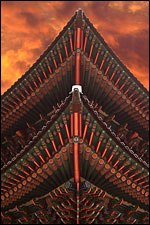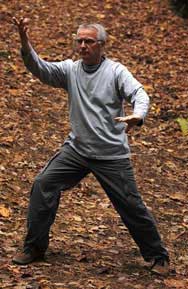 |
|
|
taijiquan
Taijiquan is a traditional Chinese discipline, a martial art that will strengthen both the mind and the body. It's not age specific nor gender specific. Everybody will benefit from its practice, including people with minor or major physical disabilities. Research has shown that over time and with regular practice, you will improve your overall health and also reduce unwanted stress levels. It is a good exercise for coordination, balance and flexibility. Taijiquan has been known and practiced as a moving meditation. Of course it is much more than this. Taijiquan has its roots in Chinese culture and is part of its heritage. It is also influenced by Taoism and Buddhism, I Ching, Five Element Theory, Yin Yang Theory, and Qi Theory. It's a science, an art to be discovered through a lifetime of study and research. Not every student has the luxury to make such a commitment, however, one can still enjoy and learn taijiquan and reach quite an advanced level. Making a commitment for daily practice is the difficult part. Setting a time every day to practice and sticking with it, is the secret. Classes are very important, however, your personal training when done correctly is where you really learn, it's where you make discoveries and breakthroughs. Every level brings new challenges and the fact remains that the basic and core principles should continue to be implemented and studied with increased intensity. Yang, Chen, Wu, and Sun are some of the main styles. Each style has been developed with specific theories and principles. It's not uncommon to see different schools with a varied curriculum. Some tend to focus more on the health side and some focus more on the martial side. Some schools prefer to teach both. Taijiquan is meant to be transformed and reflected in our everyday lives. The reality is that we live in a push and shove society that hardly leaves any room for peace and well being. We know it is too easy to meditate and be relaxed in an ideal location away from the realities of our world. Learning to blend and redirect the negative forces can certainly prove to be an asset in this reality. Otherwise it becomes only a meaningless activity. That is a good way to make use of the philosophies that are at the root of this system, and to make a connection between mind and body.
Forms are a series of movements done in a specific order that has for objective to teach and train both the mind and the body. The mind has to be in the present moment and focused with the movements. Body and mind must remain relaxed but at the same time energized. This quality is also referred to as peng energy, the first and probably the most important energy found in taijiquan. The foundation and structure of each form has to reflect proper alignments and body mechanics. Also, each movement has to originate from within, or from the lower dantian and stay within the reality and shape of your own body size. The forms are many and varied, from slow to fast, barehand and with weapons, solo and paired. The function and martial applications of each form are required in order to understand taijiquan.
Taiji Classics are a series of guidelines or better still, profound documents that were written and passed down from one generation to the next. Careful study of the classics will reveal the principles that make up the art of taijiquan. We have to be thankful to numerous masters who have come forward and devoted their time to translate the hidden treasures from the sages into a language that we can understand.
Thirteen Postures can be regarded as the foundation of all taijiquan skills. In other words, everything evolves from here. Eight hands skills - Peng (wardoff), Lu (rollback), Ji (press), An (push), Cai (pluck), Lieh (split), Zhou (elbow), Kao (shoulder) and five footwork skills Jin Bu (advance), Tui Bu (retreat), Zuo Gu (gaze left), You Pan (look right), Zhong Ding (central equilibrium) (spelling can vary). The first four energies are also referred as primary energies or square energies and the other four are considered secondary energies or diagonal energies and they assist or supplement the first four. The footwork skills are about displacing your body.
|
||
|
last updated on September 20th, 2022 |
|
About Us | Taiji | News & Events | Articles | Resources | Contact Us |
|

 Forms
Forms